
It has been a year of change at Google. A barrage of updates to the format of mobile search result pages have thrown the organic search performance for many retailers into chaos.
Many of these changes are related to increases in what we call “rich answers.” These changes primarily take two forms: increased frequency of rich answers and alterations in the positioning of rich answers. (Hint: They’re now largely showing above the first organic listing, rather than between listings 1 and 2.)
Aside from rich answers, we’ve also seen changes to a couple of paid placements that have had similarly strong impacts on organic search performance for retailers, especially those with established brands that have brick-and-mortar locations. All of these changes suggest that Google is in the midst of a major mobile transition.
Our aim here is to help show where Google has been, where it’s going and where we need to be.
Rich Answers
Stone Temple Consulting recently released a study showing a significant increase of rich answers in Google search results pages (SERPs) between December 2014 and July 2015. During that period, the study found an increase in rich answers from 22.6 percent in December to 31.2 percent in July for a specific set of queries. These numbers are across both mobile and desktop.
Our contention is that rich answers appear on mobile devices at a much higher frequency than on desktop. Google is transitioning to rich answers quickly, and, as with many recent SERPs changes, they are pushing that transition through mobile search.
For the purposes of this article, we are using the same definition of “rich answers” that Eric Enge uses in his write-up of the case study:
A “rich answer” is any attempt by Google to answer the searcher’s query in search results in a way not requiring a click through to a website.
Google Local Pack
Google has been grouping Maps listings into a single block of results for quite some time. However, over the summer of 2015, Google reduced the number of visible results in this block from seven to three.
At first, this news was welcome to two groups: 1) websites that already ranked in the Top 3 Maps results in the Local Pack, and 2) websites who ranked #2 in the organic search listings. (At the time, the Local Pack was generally served between the first and second organic search result.)
But Google’s changes didn’t stop there. Shortly after rolling out the new truncated Local Pack, Google made a shift in its placement. Now, for most mobile searches, the Local Pack is placed above all organic results, generally positioned between the Paid Search Ads and the organic listings.
Much like the reformatted paid sitelinks, this simple switch of position between two elements has had a profound impact on organic search sessions, even for websites ranking in position #1 of the organic results.
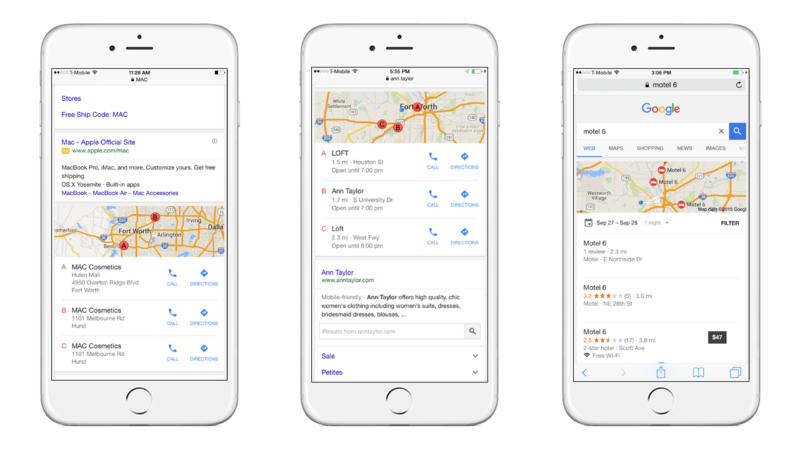
Google Knowledge Graph
Similar to the Local Pack, Google has also started serving a modified version of the “Knowledge Box” above organic search results on mobile. We first observed this happening with regularity during the first and second week of August 2015.
This does not appear to be a fully universal change, as many brands still do not generate Knowledge Box results. However, for retailers that have a substantial brand presence online and also have a brick-and-mortar presence, such results appear to be generating quite frequently.
Some of these boxes have normal Knowledge Graph info (logo, descriptions, social profiles), but others serve little more than an extended local result, generally using info pulled from the Google My Business page for the closest location to the user at the time. Below, we’ve included search examples for a variety of retail competitors, including Ann Taylor, J.Crew, Banana Republic and Gap.
Google Answers
Another piece in the Great Mobile SERPs Shuffle of 2015 (C’mon, admit it, that’s pretty spiffy and will totally catch on… guys?) is the increased presence of Google “Answers.”
For those unaware, Google Answers are the boxes displayed above all organic search results that appear to directly answer a question posed to Google. These results show up most often on queries beginning with “what” or “how,” where the query itself suggests that there is a definite answer.
Answers themselves are sometimes sourced from a trusted partner (as with weather information, dictionary definitions and so on) and sometimes pulled from third-party websites (known as “featured snippets“).
As Google users continue to adopt more natural language queries (and let’s not forget about Voice Search), these boxes are expected to show up with increasing frequency.
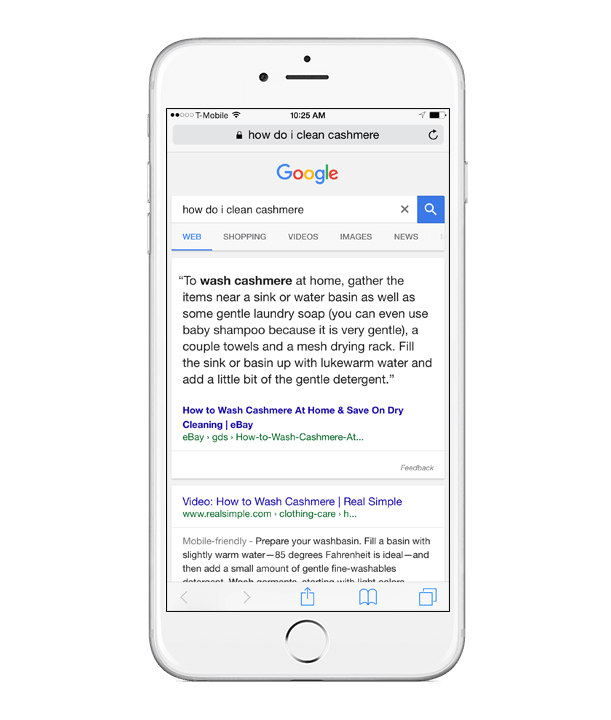
An example of a featured snippet in Google mobile SERPs
Beyond that, Google itself is adapting its own self-view, seeing itself as the provider of information, more than just a traditional search engine. Google even says so itself. Take this quote found on a Google Developers page:

It’s also worth noting that areas with poor cell reception and limited WiFi are almost never served rich answers in search results. SERPs containing rich answers are much heavier pages than a list of 10 text search results.
Google will almost always choose the path of best customer experience. In that situation, they prefer speed to fancy results. Also, as most urban areas are pretty well-covered in terms of cell reception, they tend to have a higher concentrations of rich answers served in results.
Paid Channel Adjustments
As we said earlier, these changes are not all coming from the influx of rich answers. We’ve also seen some significant changes to paid placements.
Paid Search Sitelinks
Paid sitelinks have been the source of many an SEO headache, even prior to this summer. In August, this frustration hit a new level when Google altered the standard paid sitelink format.
Prior to August, the default sitelink format on mobile devices included two columns of up to three sitelinks each. The new format includes a single column of up to four sitelinks. While reducing the total number of sitelinks, this change significantly increases the vertical space used up by the paid ad.
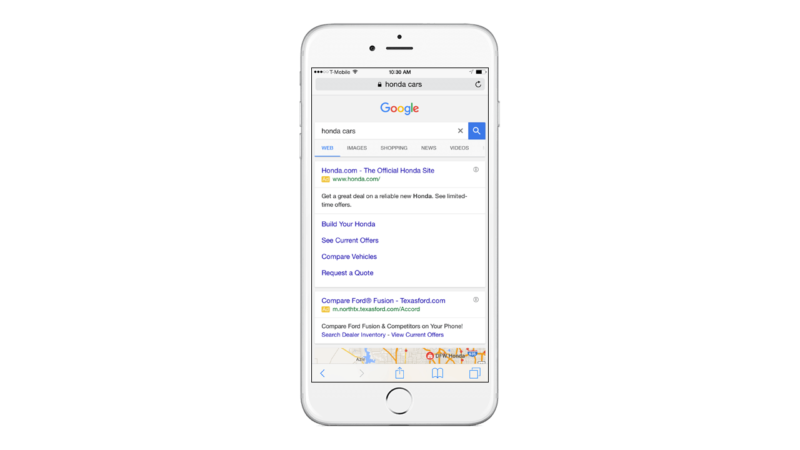
Expanded PLAs
The last of Google major mobile SERP changes this summer was around mobile Product Listing Ads. PLAs (or Google Shopping, as they like to call it now) have been a boon to paid programs. Their high CTR and conversion have helped drive both sessions and revenue for retailers of all sorts.
This summer, Google expanded the layout of PLAs on mobile devices, increasing the product image and product title text size. This increase has added to PLAs’ vertical presence pushing down all organic listings by the equivalent of one or two rank positions.
In addition to the size changes for PLAs, Google has introduced Category-level PLAs on mobile devices. These are not traditional PLAs, as they do not link to a specific product. Instead, Google serves a carousel of categories from one site (in the example below, Lafayette 148 New York). Each category box links to a separate Google search but highlights Google Shopping results exclusively.
If that category is clicked, the user ends up on a Google search page with all PLA results.
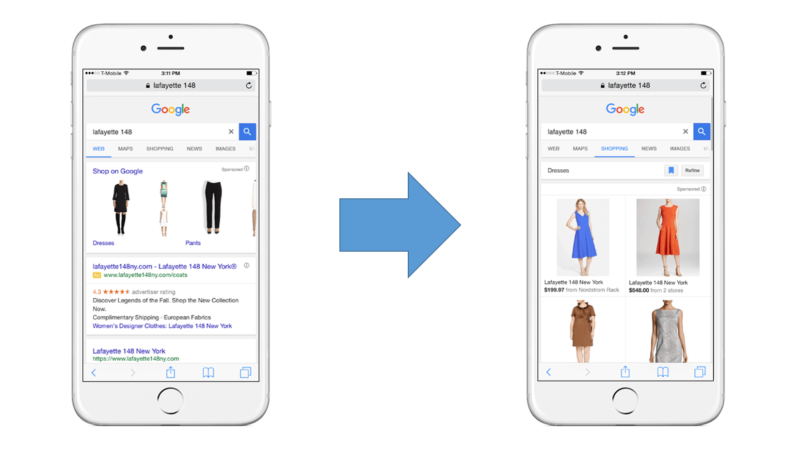
Impact On Organic Search
In short, these changes have had a profound impact on organic search performance for a number of retailers. One client, in particular, has had all of these changes apply to searches where they routinely ranked number 1. Because of the brand-heavy intent to most of these queries, it is brand-related searches that are the hardest hit.
If even one of these changes is present in a search, the organic channel is affected. We are seeing lowered organic positioning equal to at least one full rank position — without an actual change in rank.
If multiple elements are present, such as mobile sitelinks and Knowledge Box, the top organic result now falls below the fold on mobile devices with both small and large displays. If the result is seen on a smaller phone, such as an iPhone 4, the top organic result is now more than one full screen scroll below the fold of page 1.
The impact of these changes is the havoc wreaked on organic CTR and can be seen in historic WMT (Google Webmaster Tools) data for the month of August. Based on the data from Google Search Console, many retailers we spoke with reported sharp drops in CTR for their top core brand terms during the month of August. Many of these drops were by 10 percentage points or more. Once again, this is without a drop in organic impression volume or a drop in organic rank.

In the graph above, a core brand term’s CTR dropped from 41 percent to 32 percent, even though the rank position of that term remained in position #1. Because this is a core brand query, this client experienced a sharp and sudden decline in organic visits.
Where is that traffic going? Probably a variety of places. With so many factors contributing to this drop-off, it is difficult to accurately account for all the missing traffic. Some will go to Paid Search, some to PLAs, some to Google Maps and so on.
We must also consider the possibility of overall CTR on Google SERPs going down. As Google increases the frequency of rich answers in SERPs, shouldn’t we conclude that many searchers are getting their requested information without needing to click on a link?
It would follow that some people will search for something, find what they are looking for in one of a variety of new content-focused SERPs features, and then discontinue searching. In situations such as this, the need to click on a search result simply vanishes.
It is possible that some websites are not losing clicks to anyone. Some clicks are becoming unnecessary. Google is fulfilling their intent and providing value within the SERPs.
As the mobile search segment continues to grow, it becomes paramount for retail sites to harness their mobile audiences. The changes made over the summer of 2015 have made this a very difficult task from an SEO perspective. It’s not entirely impossible, but it does cause us to rethink how we normally approach SEO.
So What Do We Do About It?
Compensate Via Paid Channels
The immediate reaction to these changes would be to counter it through paid channels. If Google is replacing the top organic result with paid search ads, PLAs and so on, retail brands must claim and/or maintain the top paid listing for branded queries.
Optimize For Rich Answers
Another tactic is to start crafting on-page content optimized for Google Answers. If Google is truly transitioning to an answers provider — rather than just listing search results — it could greatly benefit brand sites to have content that matches their audiences’ most common questions.
Does this mean an epic comeback for FAQ pages? Perhaps. But this is bigger than that. It’s about really understanding what audiences are looking for and having the clearest, most relevant content that addresses their needs. The better a brand can anticipate the intent of their search audience, the easier it will be to craft content that Google will want to surface in rich answers.
Moving to a Mobile Application
One final tactic retailers are taking is updating and optimizing their apps for indexing on both Android and iOS. Google has enabled Android mobile app indexing for some time and recently announced the ability to index the content of iOS apps, as well.
This means brands with apps can target specific content within their mobile app via paid search and organic search. By applying code that equates certain app content with specific pages on their websites, websites enable mobile devices to “deep link” to their app content.
This functionality results in users being directed straight into the relevant content in the mobile app, rather than a mobile web page in Safari or Chrome. That carries with it improved mobile functionality and experience, as well as a far greater chance for conversion.
Conclusion
During the summer of 2015, Google introduced updates to five major components of various mobile search results layouts. All of the changes either reduced the real estate of the organic results and/or continued to push the organic results below the fold on mobile devices.
SEO has always been about adapting to changes in search engine templates, layouts and algorithmic preferences. Today, mobile technology has altered the ways people interact with search. Google is responding by tailoring mobile search layouts to meet those new forms of engagement. Ultimately, these trends will force us to rethink our approach to SEO.
FURTHER READING:
- The Definitive Guide to Google’s Rich Answers by Eric Enge
- Google Glossary: Revenge of Mega-SERP by Dr. Peter J. Myers
- Study: Google’s New Local Pack Shows In The Number One Spot 93% Of The Time by Barry Schwartz
- Shopping Apps Are Now The Fastest Growing Thing In Mobile by Brian Solomon
And, just for fun…
- Dissecting Google Conspiracy Theories by Clay Cazier
The post Google’s Year Of Change Hits Mobile Retail appeared first on Search Engine Land.
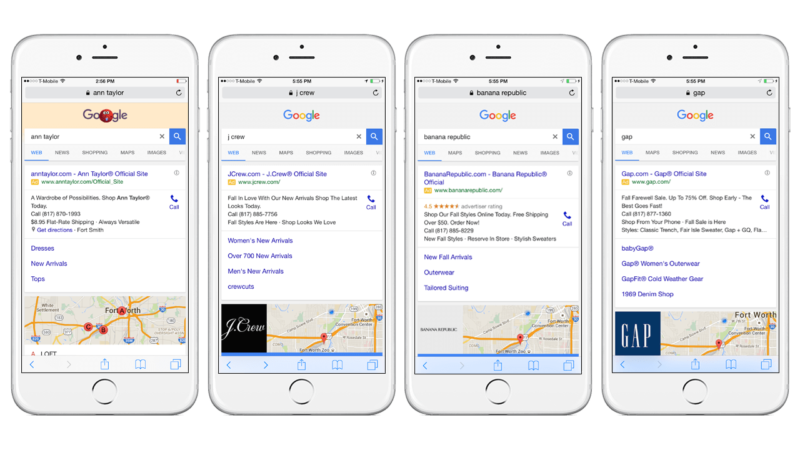
No comments:
Post a Comment